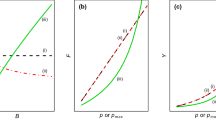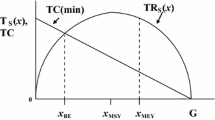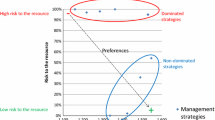Abstract
Part III discusses management models. Chapter 11 reviews the management strategy evaluation (MSE) framework, in which the performance of harvest control rules (HCRs) or management procedures (MPs) are continually evaluated using operating models (OMs). Then, the authors introduce the fish stock management system and an example of the HCR development process in Japan. Chapter 12 reviews the ecosystem models developed and employed so far in fisheries science worldwide. The authors also propose a new ecosystem assessment model for use in data-limited situations and conduct a simple simulation test to investigate the performance of the new model, applying it to North Pacific multispecies data.
Access provided by CONRICYT-eBooks. Download chapter PDF
Similar content being viewed by others
In order to realize sustainable fisheries, all information related to the dynamics (Part I) and the estimated states of target stocks derived from data collected by repeated monitoring (Part II) should be integrated and directed toward planning effective fisheries management actions. When, where, and how should the fishing effort be devoted to stocks? How should the amounts of catches from the stocks be controlled and allocated spatiotemporally? What harvest strategy should be planned to fulfill the management objective by avoiding risk in a broad range of uncertainties inherent in the natural system?
Management science in fisheries has recently made great progress as a systematic approach to implementing a system for such decisions by integrating all related information with the aid of computer capacities and applications to conduct intensive simulations. The management strategy evaluation (MSE) framework represents a systematic approach, and the number of examples reported in the literature is growing. Chapter 11 reviews the MSE framework, in which the performance of harvest control rules (HCRs) or management procedures (MPs) are continually evaluated through intensive computer simulation testing using operating models (OMs) on virtual stock dynamics and information from repeated monitoring of the status of target stocks. In this framework, sequential information update is an essential process in feedback control and for adaptive management of stocks under various uncertainties. Next, following the review of the MSE approach, the authors introduce the fish stock management system and an example of the HCR development process in Japan in Chap. 11, which seldom appear in the English literature until now. However, it would be impossible to review all of the current developments in this fast-evolving research field within the limited space of this book. The text in this book will recommend specialized books and journals that exclusively focus on this theme for readers who are more concerned about this subject (e.g., Rice and Connolly 2007; Bence et al. 2008; Holland 2010; Punt et al. 2014; Edwards and Dankel 2016; Punt et al. 2016).
In recent years, the concerns in fisheries management have been evolving from conventional single-species management to an ecosystem approach to fisheries (EAF) or ecosystem-based fisheries management (EBFM), which pursues sustainable fisheries while conserving ecosystem integrity. The EAF and EBFM account for the community structure, interactions among species, and environmental influences in the ecosystem and try to receive valuable ecosystem services from the natural system continually. Chapter 12 reviews the ecosystem models developed and employed so far in fisheries science worldwide: Ecopath with Ecosim, Atlantis, MSVPA, GADGET, and so on. These models are generally “data-hungry” and require intensive data collection and/or many assumptions related to the complicated interactions among species. In practical fisheries management, however, data to evaluate ecosystem status are generally limited. Thus, the field needs simple models to assess ecosystems that only require accessible data and minimal and realistic assumptions for rapid and robust global ecosystem evaluation. In Chap. 12, the authors propose a new ecosystem assessment model for use in even data-limited situations and conduct a simple simulation test to investigate the performance of the new model, applying it to North Pacific multispecies data.
In the present book, we could not mention or discuss case studies of actual ecosystem management currently underway. This is partly because these activities are very diverse, and they are now in the process of development and seeking for innovative and effective solutions. Balanced, less-selective harvesting in body size and species while conserving community structure and functions (Kolding et al. 2016), using network systems of marine protected areas (MPAs) (e.g., Almany et al. 2009), and coastal spatial zoning including tenure system based on territorial use rights (e.g., Yagi et al. 2010), among others, will be promising research areas. Since there are quite a few publications related to EAF and EBFM (e.g., Garcia et al. 2003; Plagányi 2007; Bianchi and Skjoldal 2008; Link 2010; Glazier 2011; Belgrano and Fowler 2011; Christensen and Maclean 2011), readers are also recommended to refer to them in addition to this book.
References
Almany GR, Connolly SR, Heath DD, Hogan JD, Jones GP, McCook LJ, Mills M, Pressey RL, Williamson DH (2009) Connectivity, biodiversity conservation and the design of marine reserve networks for coral reefs. Coral Reefs 28:339–351
Belgrano A, Fowler CW (eds) (2011) Ecosystem based management for marine fisheries: an evolving perspective. Cambridge University Press, Cambridge
Bence JR, Dorn MW, Irwin BJ, Punt AE (eds) (2008) Special issue: advances in the analysis and application of harvest policies in the management of fisheries. Fish Res 94(3):207–390
Bianchi G, Skjoldal HR (eds) (2008) The ecosystem approach to fisheries. CABI, Wallingford
Christensen V, Maclean J (eds) (2011) Ecosystem approaches to fisheries. Cambridge University Press, Cambridge
Edwards CTT, Dankel DJ (eds) (2016) Management science in fisheries. Routledge, London/New York
Garcia SM, Zerbi A, Aliaume C, Do Chi T, Lasserre G (2003a) The ecosystem approach to fisheries, FAO fisheries technical paper 443. FAO, Rome
Glazier E (2011) Ecosystem based fisheries management in the Western Pacific. Wiley-Blackwell, Chichester
Holland DS (2010) Management strategy evaluation and management procedures: tools for rebuilding and sustaining fisheries, OECD food, agriculture and fisheries working papers 25. OECD Publishing, Paris
Kolding J, Jaconsen NS, Andersen KH, van Zwietend PAM (2016) Maximizing fisheries yields while maintaining community structure. Can J Fish Aquat Sci 73:644–655
Link J (2010) Ecosystem-based fisheries management: confronting tradeoffs. Cambridge University Press, Cambridge
Plagányi EE (2007) Models for an ecosystem approach to fisheries, FAO fisheries technical paper 477. FAO, Rome
Punt AE, A’mar T, Bond NA, Butterworth DS, de Moor CL, De JAA O, Haltuch MA, Hollowed AB, Szuwalski C (2014a) Fisheries management under climate and environmental uncertainty: control rules and performance simulation. ICES J Mar Sci 71:2208–2220
Punt AE, Butterworth DS, Moor CL, De JAA O, Haddon M (2016) Management strategy evaluation: best practices. Fish Fish 17:303–334
Rice JC, Connolly PL (eds) (2007) Fisheries management strategies. ICES J Mar Sci 64:577–861
Yagi N, Takagi AP, Takada Y, Kurokura H (2010) Marine protected areas in Japan: institutional background and management framework. Mar Policy 34:1300–1306
Author information
Authors and Affiliations
Corresponding author
Editor information
Editors and Affiliations
Rights and permissions
Copyright information
© 2018 Springer Japan KK and the Japanese Society of Fisheries Science
About this chapter
Cite this chapter
Yamakawa, T. (2018). Part III Description. In: Aoki, I., Yamakawa, T., Takasuka, A. (eds) Fish Population Dynamics, Monitoring, and Management. Fisheries Science Series. Springer, Tokyo. https://doi.org/10.1007/978-4-431-56621-2_10
Download citation
DOI: https://doi.org/10.1007/978-4-431-56621-2_10
Published:
Publisher Name: Springer, Tokyo
Print ISBN: 978-4-431-56619-9
Online ISBN: 978-4-431-56621-2
eBook Packages: Biomedical and Life SciencesBiomedical and Life Sciences (R0)




